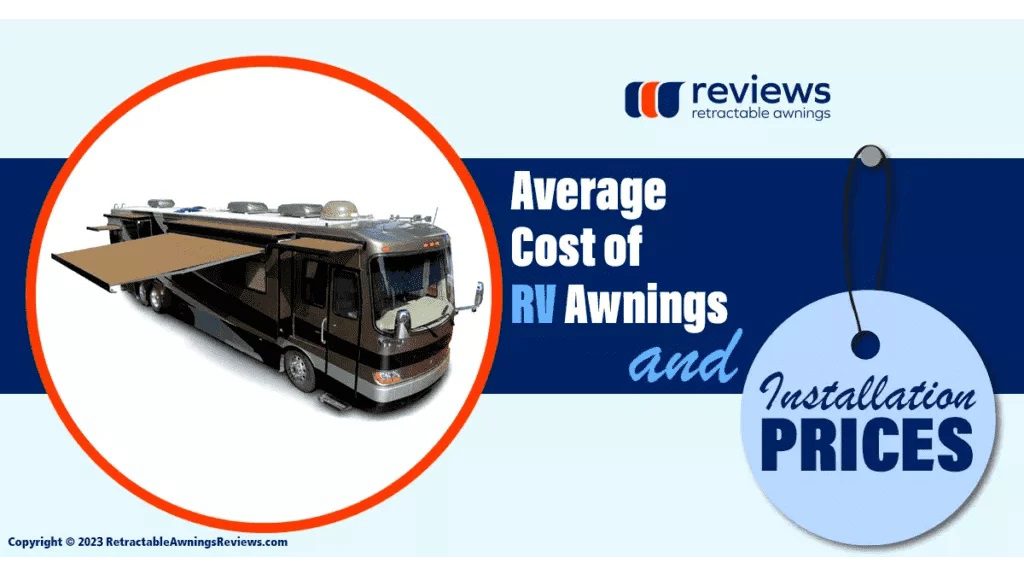Why do you need an awning for your camper or RV? Do you want to know how much it will cost to install one? Read on!
In this post, you will learn:
- What an awning is and why a recreational vehicle (RV) needs it
- RV awning costs and installation charges
- Recommendations and tips
If you’re an avid traveler with an RV or are just starting to appreciate the RV life and want to buy an awning, this piece is for you.
RV and trailer awnings come in different makes and sizes. You can find compatible awnings for any type of RV or mobile home. It’s possible to use smaller RV awnings as overhead canopies for doors and windows. Larger awnings can cover an entire side of an RV. Extremely large camper awnings can provide an extra living space or patio that can be deployed anywhere.
Ready to learn more? Let’s dig in and explore RV awnings in more detail.
Why Do You Need an RV Awning?
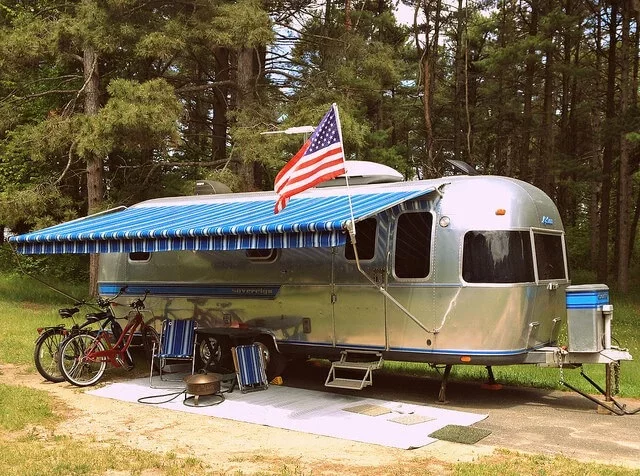
If your RV is not equipped with an awning, installing one is a good investment. Awnings are essential RV components, especially for extended camping and long tours. Let’s list the advantages of an RV or trailer awning.
Advantages of Having an RV Awning
- Having awnings on each side of an RV provides shade for doors and windows. This shade protects RVs from the sun, heat, UV rays, and glare.
- A good quality awning protects RV occupants from light rain if windows are left open.
- It can act as a patio covering for outdoor activities or a relaxing outdoor nap.
- It keeps the interior of the RV cool by keeping heat out and shielding the inside from direct sunlight.
- It can help provide privacy by acting as a window shade.
- An awning can keep air conditioning costs down.
These are the reasons to have an RV or trailer awning installed. But, there are also a few RV and camper awning drawbacks to consider.
Disadvantages of Having an RV Awning
- If the awning is not installed correctly and is not durable and sturdy, strong winds can damage an awning’s fabric, frame, or your RV’s exterior.
- Awnings require cleaning and maintenance to prevent mold and mildew. Some fabrics offer warranties against mold and mildew but none of the warranties apply if the fabric was rolled up damp or wet.
- Some campers might forget to retract the awning before driving off. This could cause harm to others and damage your awning and RV.
- It is always recommended to remove the plug from the GFI outlet prior to using the RV or trailer so that there is no possibility that the retractable awning could open while the vehicle is moving.
RV awnings provide protection and privacy but add minor maintenance costs and operational responsibility.
RV and Camper Awning Types
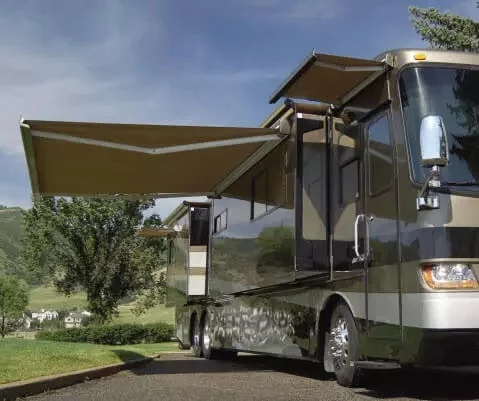
Before we tackle RV awning costs, let’s look at the various types of awnings available for trailers and RVs. An awning’s materials and retracting mechanisms are the main awning cost drivers. Many RV and motorhome retailers sell these vehicles with included awnings. You can check with a supplier to find out what RV models come with awnings.
RV Awning Types by Material
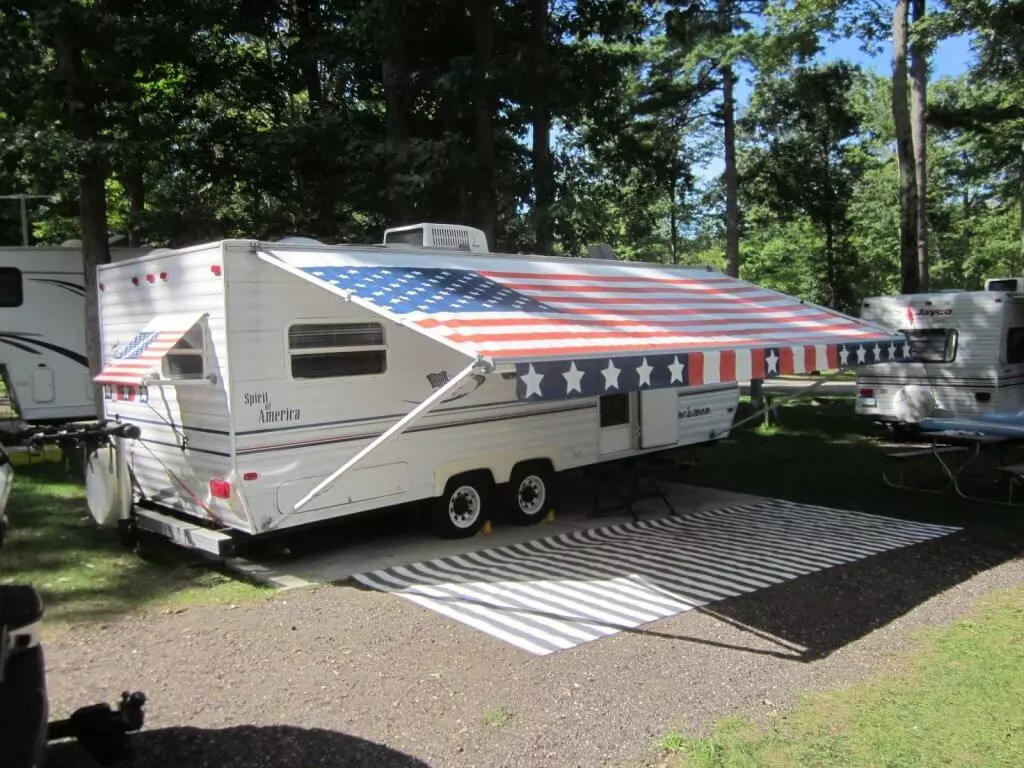
1. Solution-Dyed Acrylic Awnings
This is a common material for manufacturing awnings. It’s also one of the most affordable awning fabric types. Solution-dyed acrylic RV, motorhome and trailer awnings are water-resistant and will dry quickly if left extended as the fabric is breathable.
2. Vinyl Awnings
Vinyl awnings don’t look and feel similar to solution-dyed acrylic RV or camper awnings. An awning made from vinyl can occasionally offer more UV protection. Vinyl awnings are durable. However, these awnings will retain a lot of heat, (since vinyl is not breathable) defeating the main reason most buy RV awnings.
3. Other Fabric Awnings
Other fabrics are not commonly used for motorhome, RV, or trailer awnings due to their lightweight materials. Lighter awning materials may easily be blown off by wind. However, a few other awning fabrics are easy to retract and store, making them good choices for small RVs and mobile homes.
RV Awning Types by Mechanism or Make
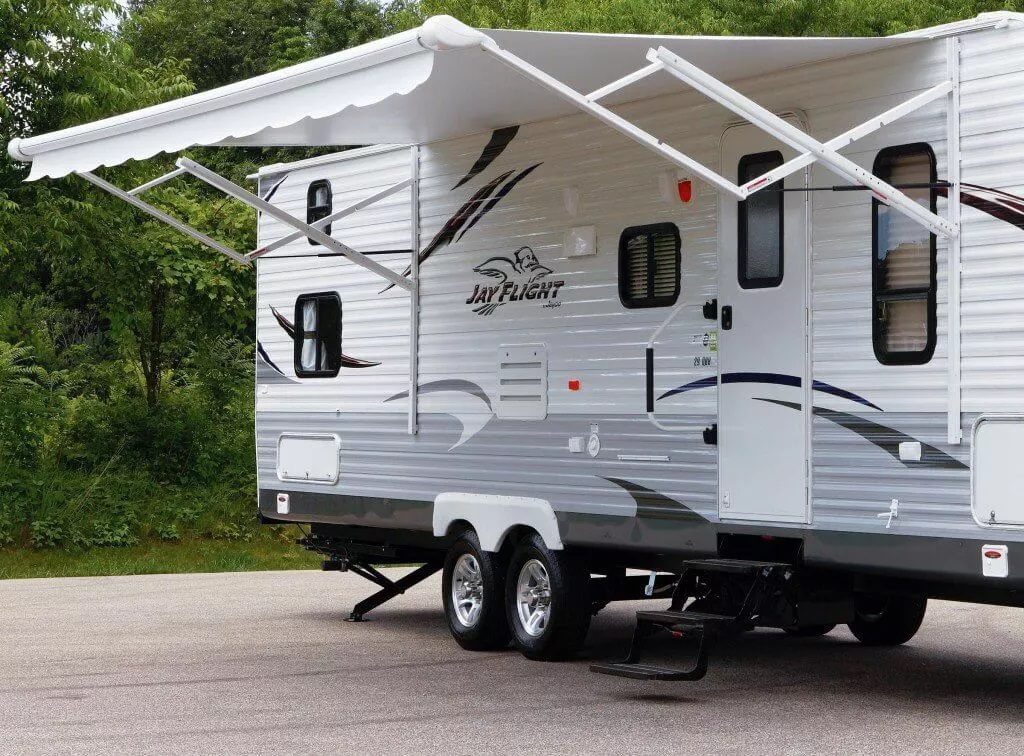
1. Slide Out Retractable Awnings
Like a pull-down window shade, the slide-out awning is normally placed on the sides of RVs. Upon parking, you can pull or slide out horizontally this type of awning to create shade or a canopy.
2. Fixed or Permanent Awnings
The best locations for fixed or permanent awnings are above an RV’s door or windows. These awnings are usually made from the same or equivalent material as an RV’s exterior and provided by the RV manufacturer. Permanent or fixed awnings can offer continuous cover from the elements even when mobile.
3. Automatic or Mechanized (Motorized) Electric Awnings
Automatic electric awnings deploy or retract with the press of a wall switch or remote transmitter. Retraction time is also faster compared to a manual-type awning. This type of awning is the easiest to use and will not take more time to install since the motor is already installed in the tube and all the customer has to do is plug it into a standard 110v GFI outlet. Since these RV, trailer, motorhome, and camper awnings are self-lubricating, they don’t require maintenance of their motorized parts. However, the support frames and fabric for these motorized retractable awnings require quarterly or semi-annual basic cleaning.
4. Shelter Type or Patio-Type Awnings
These awnings have a tent-like appearance. You can deploy a shelter or patio awning to create another living area or extend your RV’s canopy. Awning manufacturers make these awnings from canvas, fabric, or other foldable materials. Some RV and camper awning models are large canopy types, while others are almost like a room with walls, a door, and windows. This awning type is the most complicated to deploy due to its size and weight.
A variety of awning materials, types of deployment, and mechanisms are all factors in RV awning cost calculations.
How Much Does an RV Awning Cost?
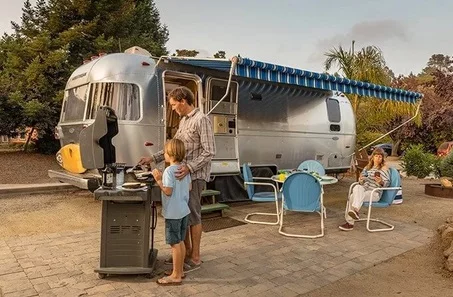
There are a lot of choices to choose from when installing an RV, motorhome, or camper awning. The average cost of RV awnings may be between a few hundred dollars for simple setups to thousands of dollars for complex ones. We prepared a table comparing approximate costs as of November 2023 for each type of RV or trailer awning. This table can help you decide what type of awning you should purchase.
These costs include installation and basic setup expenses. We did not include the cost of awning-related accessories like optional floor mats and rain guards.
|
RV Awning Type |
Size* |
Cost** |
|
Slide Out / Manual Retractable |
Small (2 feet x 3 feet) |
$500 |
|
Slide Out / Manual Retractable |
Medium (4 feet x 8 feet) |
$1,000 |
|
Slide Out / Manual Retractable |
Large (6 feet x 15 feet) |
$1,500 |
|
Fixed or Permanent |
Small (2 feet x 3 feet) |
$250 |
|
Fixed or Permanent |
Medium (4 feet x 8 feet) |
$500 |
|
Automatic / Mechanized (Motorized) and Retractable |
Small (2 feet x 3 feet) |
$1,500 |
|
Automatic / Mechanized (Motorized) and Retractable |
Medium (4 feet x 8 feet) |
$2,000 |
|
Automatic / Mechanized (Motorized) and Retractable |
Large (6 feet x 15 feet) |
$3,500 |
|
Shelter or Patio |
Medium (4 feet x 8 feet) |
$1,500 |
|
Shelter or Patio |
Large (6 feet x 15 feet) |
$2,500 |
*Shelter and patio-type RV awnings don’t come in small sizes.
**Costs may vary depending on awning materials. However, the cost difference between fabric, vinyl, solution-dyed acrylic, or canvas awnings is generally not significant.
RV and Camper Awning Installation Prices
A portion of an RV awning’s price is due to installation costs. Below is a breakdown of costs based on an awning’s size and mechanism type.
- A small RV awning is for windows and doors.
- A medium RV awning is generally for side deployment.
- A large RV or camper awning is for side patio-type deployment.
- 2 people to install are recommended for all sizes below
- Note: Installation cost will vary based on the cost of living at the installation location
|
Type |
Size |
Installation Cost |
|
Non-mechanized labor cost = $60 per hour per person Duration = 2 hours |
Small (2 feet x 3 feet) |
$240 |
|
Non-mechanized labor cost = $60 per hour per person Duration = 2 ½ hours |
Medium (4 feet x 8 feet) |
$300 |
|
Non-mechanized labor cost = $60 per hour per person Duration = 3 hours |
Large (6 feet x 15 feet) |
$360 |
|
Mechanized labor cost = $60 per hour per person Duration = 2 ½ hours |
Small (2 feet x 3 feet) |
$300 ** |
|
Mechanized labor cost = $60 per hour per person Duration = 3 hours |
Medium (4 feet x 8 feet) |
$360 |
|
Mechanized labor cost = $60 per hour per person Duration = 3 ½ hours |
Large (6 feet x 15 feet) |
$420 |
**RV and camper awning installation costs of mechanized or motorized models are a little more expensive due to the need for adjusting limit switches and motor settings. A licensed electrician is not needed to install a motorized awning, as nowadays, most awning motors include a cord and standard molded plug for either a 110v or 220v outlet.
Other Considerations
DIY installations of non-mechanized (manual) RV awnings can save you on labor costs. Due to the non-complexity of a non-mechanized electric motorized RV awning, I recommend a DIY installation. You will likely need to hire an installer if you purchase RV or camper awning kits from a local hardware or camping store.
If you’re considering installing an RV awning as a DIY project, please note the following:
- An incorrect installation won’t only damage your awning but can also harm the body and exterior of your RV, motorhome, camper, trailer, or mobile home.
- Improper awning installations can result in affected aesthetics, including being uneven or otherwise crooked.
- Whoever installs the project will need power tools and protective gear.
- Measure everything accurately to avoid incorrectly drilling holes in your RV.
- If you can’t buy your preferred awning locally, shipping costs may be high due to the large size and weight of some RV and camper awnings.
- Buying an awning out of state can help you save money by not having to pay local or state sales tax.
A DIY awning installation is possible. But you’ll have to pay attention to details to install your awning mechanisms correctly. Otherwise, saving on labor costs now may lead to more expenses later due to errors and mishaps.
Final Thoughts
We discussed all RV, motorhome, trailer, mobile home, and camper awning types available and their cost. Picking one should be easy now that we laid out the details for each type. But, for your money, you can’t go wrong with a retractable RV awning. Retractable awnings are easy to deploy when parking your RV, motorhome, camper, trailer, or mobile home. Closing or retracting this type of awning is easy before moving to another area.
If you plan to install or upgrade to a retractable RV awning, we recommend checking with professional RV awning companies to request price quotes. Request pricing on a manual or mechanized (motorized/electric) RV awning to see which option fits your budget. Lastly, check user reviews on my website to find the most professional and experienced RV awning installers and companies available.
